September 2017
Monthly Archive
Mon 25 Sep 2017
A 1001 MIDNIGHTS Review
by Bill Pronzini & Newell Dunlap
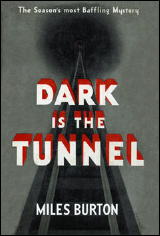
MILES BURTON – Dark Is the Tunnel. Doubleday Crime Club, US, hardcover, 1936. First published in the UK by Collins as Death in the Tunnel, hardcover, 1936.Reprinted by Poisoned Pen Press, US, softcover, 2016, under the British title.
During his thirty-seven-year career, tirelessly prolific British writer Cecil Street published almost as many novels under his Miles Burton pseudonym as he did under his more popular pen name of John Rhode. All but two of his sixty-three Burton titles feature the detective team of Inspector Arnold of Scotland Yard and his friend and amateur criminologist Desmond Merrion.
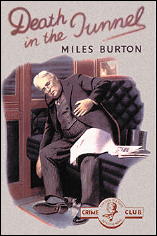
These are traditional mysteries with emphasis on deduction rather than police procedure. Emphasis is also on the stories themselves the mechanics of the puzzle — with the result that Street’s characters tend to be sketchily drawn and in many cases two-dimensional. Arnold and Merrion are not exempt; in no book do they come across as much more than puzzle-solving agents, bereft of those human characteristics that make a series sleuth distinctive and memorable.
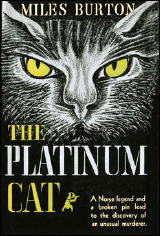
Still, Street’s plots are carefully crafted and fairly clued, and offer the reader a variety of settings (many of them English country and seaside locales), as well as interesting back-grounds and themes.
A good example is Dark Is the Tunnel, which features that ever-popular mix of murder and trains. The tunnel referred to in the title is a railway tunnel outside London-the two-and-a-half-mile Blackdown Tunnel. It is halfway through the Blackdown that the 5:00 p.m. train from Cannon Street unexpectedly comes to a stop. Apparently someone was working on the line, for the engineer saw a blinking red light, signaling him to stop, and then a green light, signaling him to proceed. But the odd thing is, there had been no report of workers in the tunnel.
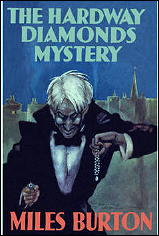
Almost simultaneously with the stop, an elderly gentle-man named Sir Wilfred Saxonby is found in his locked compartment, dead of a gunshot wound. A suicide? Perhaps, although nothing in his background suggests such a possibility.
Arnold and Merrion follow a tangled skein of motives and of clues that include a pair of wallets, a rhododendron bed, and the movements of a garage repair truck over a thirty-six-hour period, and come up with the solution to the mystery. There is little action along the way, and Street’s prose tends to be on the dry and dusty side. But the puzzle is baffling enough to provide armchair detectives with a couple of hours of pleasurable escapist reading.
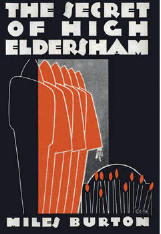
Other titles in the same vein include the first Arnold and Merrion case, The Menace on the Downs (1931); The Platinum Cat (1938); Death Visits Downspring (1941), a livelier tale than most of the Burtons, in which Arnold and Merrion solve the wartime mystery of the murdered butler and the missing radio station; and Look Alive (1950), the last Burton novel to appear in the United States, although twenty-one additional titles were published in England between 1950 and 1960.
Two other Buttons of note are The Secret of High Eldersham (1930), a tale of witchcraft in which Merrion appears alone; and The Hardway Diamonds Mystery, published that same year, which marks Arnold’s likewise solo debut.
———
Reprinted with permission from 1001 Midnights, edited by Bill Pronzini & Marcia Muller and published by The Battered Silicon Dispatch Box, 2007. Copyright © 1986, 2007 by the Pronzini-Muller Family Trust.
Sun 24 Sep 2017

MY FRIEND IRMA GOES WEST. Paramount Pictures, 1950. John Lund, Marie Wilson, Diana Lynn, Dean Martin, Jerry Lewis, Corinne Calvet, Lloyd Corrigan, Don Porter, Harold Huber, Kenneth Tobey. Screenplay: Cy Howard & Parke Levy. Director: Hal Walker.
Marie Wilson, who made a career of playing ditsy blondes, will be remembered best for her portrayal of Irma Peterson, the impossibly vacuous New York City secretary with a mind the size of a paper clip. This was the second film to feature Irma, who began her career on radio in 1947, but as usually the case, of all the people who were in the cast on the radio program, only Marie Wilson managed to make the transition into the movies.

And even though creator Cy Howard was also involved in the movie production, much of the magic her character created in her original form is gone. In fact, Irma is on the screen far less than the up-and-coming comedy team of Martin and Lewis. Incidentally, they also appeared in the first Irma picture as well — their screen debut, no less.
The plot is simple enough — Dean Martin, who plays the boy friend of Irma’s friend Jane, gets a shot at Hollywood, or so he thinks, and the whole gang goes along. It;s to bad that, unknown to them, the boys in the white suits come along afterward to pick up the “producer” who hired him. (But what about the French actress with eyes for Dean?)
Irma continued on the radio for four more years, until 1954, but there weren’t any more movies. It’s no wonder why. When writers lose the roots of their own creations, chances of a successful transplant are next to none.
— Reprinted from Mystery*File #24, August 1990 (very slightly revised).
Sun 24 Sep 2017
SELECTED BY L. J. ROBERTS:
WILL THOMAS – An Awkward Way to Die. Cyrus Barker & Thomas Llewellyn. Minotaur Books, eBook, novelette, 85 pages. August 2017.

First Sentence: The telephone set jangled on the corner of Cyrus Barker’s desk, and we both turned our head to stare at it.
The personal tobacconist to Private Inquiry Agent Cyrus Barker has died. He was murdered in his shop. His body found in his humidor. It is up to Scotsman Barker, and his Welsh assistant Thomas Llewellyn, to find the killer.
If one has not previously read Will Thomas, this is a wonderful introduction to his Barker and Llewelyn series.
Thomas’s dialogue and subtle wry humor are always a pleasure to read— “Someone had died,†I stated. “Aye,†the Guv answered, “It is Vasilos Dimitriadis.†“Your tobacconist?†“The same.†“Isn’t he the one who blends your tobacco for you but won’t say what is in it?†“Not ‘isn’t,’ Mr. Llewelyn. ‘Wasn’t.’ Scotland Yard has required our presence immediately. Come along.â€
With the story set in Victorian England, Thomas cleverly calls out the dismissiveness toward women and prejudice towards foreigners— “It was always easier to blame a foreigner, as if England had no criminal class of its own.†—demonstrating that little has changed over time.
“An Awkward Way to Die†is a clever story with the solution proving that it’s all about noticing the details. It is a delight to read, as is the entire series.
Sat 23 Sep 2017
Posted by Steve under
Reviews[11] Comments
DAVID HEWSON – The Sacred Cut. Nic Costa #3. Delacorte Press, US, hardcover, December 2005. Macmillan, UK, April 2005.

There are not many types of mysteries that I do not read, but there are a few. I remember once expressing my disinterest in detective stories with horses in them, which at the time caused a mini-uproar among Dick Francis fans, among others. Well, Dick Francis fans need no longer worry. I’ve read a couple of his books, and they were pretty good. Especially the parts that did not have horses in them.
At one time I had no interest at all in historical mysteries. Now I read them all of the time. Except for those that take place in ancient Rome. I think that relates somehow to my distaste for Latin in high school. Ixnay, I say.
I still do not read mysteries in which children are the victims. It’s bad enough to have to read about such incidents in the newspapers almost every day. Mind you that I am not saying that mysteries in which children are the victims should not be written, if they are written with the right motive in mind, but if children are hurt or killed in a work of fiction, it had damn well better be the right motive in mind.
I seldom read books about serial killers, either, which gets us closer (finally) to the book at hand. The determining factor in this sub-genre is how much blood and gore gets splattered around. Generally speaking, my rule of thumb says to assume that when a book is about a serial killer, the author somehow is going to depend on blood and gore to get his (or her) point across, that this is one nasty guy and somehow he has to be caught. Well, sure. And I’ll pass on it and read something else.
And so The Sacred Cut had a couple of strikes against it, even before I began, given the front cover of the Advance Reading Copy:
The snow is falling on the ancient streets of Rome. And in the heart of the world’s most enigmatic city, under the Pantheon’s great dome, a woman’s body lies on the marble floor. Grotesquely carved on her back is … THE SACRED CUT.
You recall what I said about ancient Rome? Well, that’s not really the setting here, but in a sense it is. The setting is as contemporary as it can be, given that the various US invasions of Iraq are to blame for the events behind the scene described in the blurb above. But generally speaking, as the blurb suggests, history does play a big part of the story, with the multi-faceted city of Rome being one the most important players.
There is, in fact, a large ensemble cast of players, and as long as the focus stays on police officers Nic Costa and his partner Gianni Peroni; their superior, Inspector Leo Falcone; the female pathologist Teresa Lupo; the female FBI agent-in-training Emily Deacon; and Laila, the youthful (female) waif refugee from Iraq who witnesses the scene in the blurb above, then all is well.
Better than merely “well.†This is as intriguing a police procedural as I’ve read in a long time. (Even if you keep in mind that for some reason, I have not read a police procedural in a long time, this is still a true statement, and I stand behind it with no qualifiers at all. (I almost said with no qualification at all, but I thought better of it.))
I have to tell you, though. After reading page 116, when the killer snaps and his scalpel starts flying and he begins flaying away, along with a handy supply of meat saws and cleavers nearby, I very nearly did not read page 117.
More of the same, I thought, and I have better things to do. My advice to you, however, is the same I gave myself. Keep on reading. You won’t regret it.
The killer is largely known; his motives are not. Either way, he’s far from the most interesting factor of the novel. It’s Falcone’s superiors who are; Emily Deacon’s superior who is; it’s the relationship between Costa and Peroni and Lupo and Deacon and (surprisingly) Laila which is. Humorous when it needs to be, sad when it needs to be, philosophical when it needs to be, and real all of the time, this is a long novel which you will wish was even longer.
What came as a surprise to me, when it was over, as I was happily sitting where I sat, doing my own wishing for more, was the discovery that this is the third in a series of Nic Costro novels, and that the fifth will be published next year. I knew that author David Hewson had written a quite a few other books I’ve seen at Borders, but they all looked like standalones to me. Filled with serial killers and/or grotesque killings.
It looks like I’ll have to go looking for them.
— Reprinted from the online
Fatal Kiss, November 2005 (slightly revised).
Sat 23 Sep 2017
REVIEWED BY DAVID VINEYARD:
DAVID HEWSON – The Villa of Mysteries. Nic Costa #2. Delacorte Press, hardcover, January 2005. Dell, paperback, August 2005.

If you haven’t read David Hewson’s literate and well written thrillers about Rome’s forensic pathologist Teresa Lupo and detective Nic Costa, you are in for a treat.
The pair debuted in A Season for the Dead, which was filmed with Mira Sorvino, and now they are back in another dark and forbidding outing with echoes of Dan Brown and the Da Vinci code school, true Gothic atmosphere, conspiracy theory, the detective novel, and taut suspense.
In The Villa of Mysteries the body of a long dead young woman found partially mummified in a bog leads Teresa and Nic into a similar case that has just happened. How the two cases connected and why spins out of control into violence, Italian history, and adds a twist to the serial killer novel with sacrificial murder and the rituals of a secret society involved.
The finely detailed background, authentic research, a combination of human drama, and a plot that is complex but never static and combined with a taut line of suspense make Hewson one of the best writers to explore this sub-genre of the thriller.
Even if like me the words serial killer are enough to turn you off most thrillers, this one is truly different, and if you have grown weary of the Da Vinci Code school and the parade of forensic pathologist sleuths, this offers much more than either. The view of police work in Rome, the use of the cities dark corners, and long buried ancient evils is palpable in Hewson’s writing making his books much more than a rehash of what has been done before.
For superb use of setting and atmosphere, intriguing plots, believable and attractive (and not so attractive) human characters, and fine writing you can’t go wrong with David Hewson or The Villa of Mysteries.
The Nic Costa series —
1. A Season for the Dead (2003)
2. The Villa of Mysteries (2004)
3. The Sacred Cut (2005)
4. The Lizard’s Bite (2006)
5. The Seventh Sacrament (2007)
6. The Garden of Evil (2008)
7. Dante’s Numbers (2008) aka The Dante Killings
8. The Blue Demon (2010) aka City of Fear
9. The Fallen Angel (2011)
Fri 22 Sep 2017
I’ve asked Chuck Harter, the author of the following book to tell us more about it. He’s most graciously agreed:

CHUCK HARTER – Mr. Novak: An Acclaimed Television Series. Bearmanor Media, hardcover, softcover and eBook, illustrated, 15 October 2017.
This book is a comprehensive look at a classic dramatic television series that aired for two seasons in the early 1960’s. It was filmed at the MGM studios, aired on the NBC network and showcased life at a typical American High School.
The program starred James Franciscus as teacher John Novak with first Dean Jagger then later Burgess Meredith as the Principal of the school. Mr. Novak was the first series that portrayed teachers and students in a realistic dramatic manner.
Previously there had only been sitcoms which didn’t reflect the lifestyles of the real students of America. The series featured top quality scripts, actors and production and won over 47 awards during its run including the prestigious Peabody Award for excellence.
Many of the awards came from academic institutions which praised the show for its portrayal of the educational community. Such was the impact of the production that it prompted many to become teachers and many existing educators to improve their skills.

The book traces the evolution of the series from development to the pilot’s production and acceptance by NBC. It then covers the filming and airing of the first season to great acclaim.
The second season, which was fraught with controversy and discord is then examined with the result being cancellation.
The legacy of the principals involved with the series is examined along with comments by those that continue to be interested in this vintage classic dramatic series of superior values.

The book contains exclusive interviews with over 40 actors including Ed Asner, Frankie Avalon, Diane Baker, Beau Bridges, Johnny Crawford, Tony Dow, Sherry Jackson, Tommy Kirk, Walter Koenig, Martin Landau, June Lockhart, Beverly Washburn and many others. There are 243 illustrations and an index, including a complete episode guide with full credits, plot descriptions, vintage interviews, and new appraisals by the author.
There is also an extensive appendix with a list of the awards Mr. Novak won, Producer E. Jack Neuman’s writer’s guide for Mr. Novak, An advice column for High School graduates by star James Franciscus, Principal Vane’s (Dean Jagger) speech to the new teachers, the Mr. Novak board game and more.
The Introduction of the book is by A-List Director Richard Donner: “I’m so glad Chuck Harter is brining the Mr. Novak experience to a wider audience…read his detailed behind-the-scenes account.â€

The Foreword is by the late Martin Landau: “Chuck Harter has produced a superlative book that is both fascinating and informative.â€
The Afterword is by Star Trek actor Walter Koenig: “You don’t have to be an actor…just a student to appreciate the skillful way in which Chuck Harter unfolds the stories behind the cameras.â€
Mr. Novak was a television series of exceptional quality and the amazing thing is that when episodes are viewed today — they are not dated or corny but are still relevant to modern times.
The book is also available at Amazon.com, while the Official website is https://mrnovakbook.com/
ANNOUNCEMENT : Warner Home Video is going to release the first season of Mr. Novak (30 episodes) in a DVD set in 2018. They will be struck from the original 35mm camera negatives and should look pristine.
Fri 22 Sep 2017
REVIEWED BY BARRY GARDNER:
MICHAEL BOWEN – Corruptly Procured. Richard Michaelson #3. St. Martin’s, hardcover, 1994. No paperback edition.

Bowen has another three-book series going about a married couple, plus at least one other book, but the Michaelson books are the only ones I’ve read. None have appeared in paperback, as far as I know, which is a shame.
Richard Michaelson is a retired Foreign Service man in his early sixties, hoping for an appointment someday to a top policy post at State but so far disappointed. He is approached by a man who once worked for him, now a top DC lawyer, to do some consulting work for which he seems ill-suited, a a price which seems high.
Puzzled, but not enough so to overcome his lack of interest, he refuses. The offer is made at a gathering at a branch of the Library of Congress, and shortly thereafter a bomb explodes, injuring Richard and masking the theft of a priceless Gutenberg Bible. While he is in the hospital a high-ranking Treasury official urges him to accept the consulting job, for reasons left shadowy.
A hitherto unremarkable German activist group claims credit for the bombing and theft, and vows more. Can it all be connected? Well, of course it can, silly.
I like the Michaelson books. If Bowen doesn’t know his way around the Capital and its machinations and flora and fauna, he fakes it well. He tells his story form multiple viewpoints — though Michaelson’s is by far predominant — and keeps it moving in a reltively straight but very complex line.
This one was perhaps a little more complex than usual, and a trifle more melodramatic, but still enjoyable. Michaelson and his bookstore-ownng lady Miranda [Marjorie?] are amiable characters, and I look forward to seeing them again.
— Reprinted from Ah Sweet Mysteries #13, June 1994.
The Richard Michaelson series —
1. Washington Deceased (1990)
2. Faithfully Executed (1992)
3. Corruptly Procured (1994)
4. Worst Case Scenario (1996)
5. Collateral Damage (1999)
The husband-and-wife series that Barry referred to in his first paragraph must be the Thomas Curry and Sandrine Cadette Curry books, of which there were three (1989-1993). He also wrote five books about Rep and Melissa Pennyworth between 2001 and 2009, and one book (so far) about Josie Kendall (2016). These plus three apparent standalones constitute quite a substantial mystery writing career.
Thu 21 Sep 2017
REVIEWED BY DAN STUMPF:

HOUSE OF DARKNESS. International Motion Pictures, UK, 1948. George Melachrinos, Henry Oscar, Lesley Osmond, Alexander Archdale, John Teed, Grace Arnold, and introducing Lawrence Harvey. Written by John Gilling. Directed by Oswald Mitchell.
A stylish little quota quickie that brought Lawrence (or Laurence) Harvey to the screen and established his persona for all time.
Orchestra leader George Melachrinos, an arranger in the Mantovani/Kostelanetz mode, starts off the film relating a ghost story about visiting a haunted mansion, setting up a flashback to the lives of its last tenants, a family that make The Little Foxes look like the Brady Bunch.

It seems sometime before the story started, stodgy eldest son John (Alexander Archdale) was left in control of an estate that younger half-brother Francis (Harvey) thinks should be his. And since John suffers from a weak heart while Francis has no heart at all, the writing — or more accurately the script — is on the wall for all to see, especially after John is out of the way and Harvey drives his other sibling off by convincing him that John’s Ghost walks the halls at night.

No surprises here, but writer john Gilling (who went on to some fine horror flicks at Hammer) seems to have gauged Harvey’s screen persona perfectly (Brother John calls him “An insufferable, conceited cad,†which puts it very neatly) and written lines that only he could do this well. And when John’s ghost actually makes his return, it’s done with a creepy understatement that comes off very well indeed.
House of Darkness doesn’t quite escape its quota quickie onus, but it works quite nicely as an effective ghost story and a showcase for an up-and-coming star who would have done better to stick to parts like this.
Thu 21 Sep 2017

MOTIVE FOR REVENGE. Majestic Pictures, 1935. Donald Cook, Irene Hervey, Doris Lloyd, Edwin Maxwell, William Le Strange Millman, Russell Simpson, John Kelly, Edwin Argus. Director: Burt P. Lynwood.
Just because some moves have managed to survive to the present day does not mean that they are gems of any sort, semi-polished or completely in the rough. Take Motive for Revenge, for example. It is a movie that tries, but that fact is, it does not have any idea what kind of movie it is trying to be.
First it is a comic noir film, with a henpecking mother-in-law hectoring her wife’s husband (Donald Cook) to commit a crime; then he’s caught, and it’s a prison film, complete with extended scenes of convicts marching in formation in and out of their cells.

Then it’s a crime film, with Cook out of jail and looking for his wife (Irene Hervey) and her new husband (she didn’t wait for him, as she promised); then a murder mystery, when the new husband being shot, and neither Cook nor Hervey sure whether the other did it or not; then a chase film, as the cops (including two of the dumbest clucks to be promoted off the beat) try to nab the two of them, first on board a yacht then in a couple of speedboats racing along the shore. All in a running time of some 60 minutes.
It’s really not very good at any of these. While Cook stands around brooding a lot, the mostly charming Irene Hervey largely steals the show, but it would have helped if her character showed at least one ray of intelligence. Some of the rest of the characters are vaguely familiar, but that’s who they were, I’m sure, character actors all of their careers.
Wed 20 Sep 2017
I returned home from L. A. last Wednesday limping badly, so I called and got an appointment at UConn Health this past Monday. They looked at Xrays of my hip and made an official diagnosis of arthritis (my chiropractor had already suggested this) and scheduled me for a cortisone shot in my hip this morning.
I was there for two hours but the procedure itself took less than five minutes. All is well, except that as whatever they used to numb the area is starting to wear off, and my leg is starting to ache, as they said it would. Back to normal activity tomorrow, but I have to keep monitoring how I’m doing and record the results in a diary until my followup visit with the doctor.
Having the injection is a stop-gap procedure often used to delay having a hip replacement done. I agreed that I’d want to postpone that for a while! Having this done means in fact that I can’t have a replacement done for three months, which is fine with me.
So I’m OK, and more than willing to take a day off just to rest. Back to my regular schedule tomorrow!
« Previous Page — Next Page »




